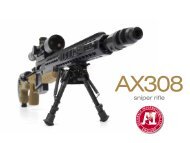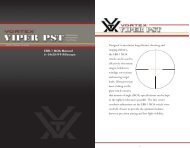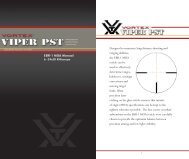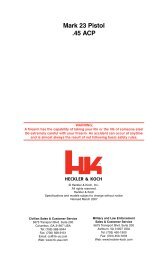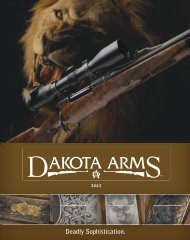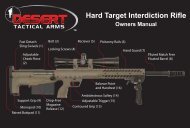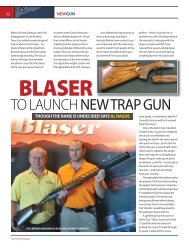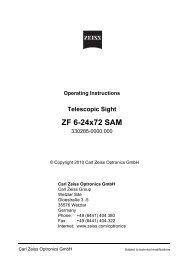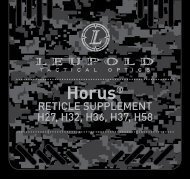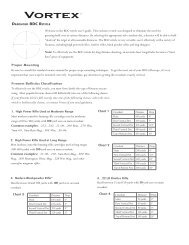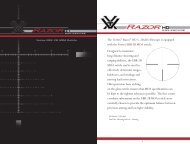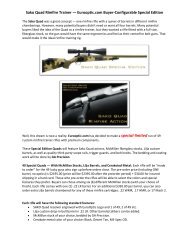USING THE TACTICAL RETICLE SYSTEM - Leupold
USING THE TACTICAL RETICLE SYSTEM - Leupold
USING THE TACTICAL RETICLE SYSTEM - Leupold
- No tags were found...
Create successful ePaper yourself
Turn your PDF publications into a flip-book with our unique Google optimized e-Paper software.
<strong>USING</strong> <strong>THE</strong> <strong>TACTICAL</strong><strong>RETICLE</strong> <strong>SYSTEM</strong>MIL DOT / TMR ® / SPR ® / CM-R² TM / BLACKOUT / CM-RWUSAGE INSTRUCTIONS
Table of ContentsThe <strong>Leupold</strong> Mil Dot and Tactical Milling Reticle (TMR) . . . . . . . . . . . . . . Page 2Parts of the Mil Dot and TMR Reticle . . . . . . . . . . . . . . . . . . . . . . . . . . . . . Page 3Using the Data Obtained with the Mil Dot or TMR Reticle . . . . . . . . . . . Page 8Special Purpose Reticle (SPR ® ). . . . . . . . . . . . . . . . . . . . . . . . . . . . . . . . . . . Page 23Close Mid-Range Reticle (CM-R² TM ) . . . . . . . . . . . . . . . . . . . . . . . . . . . . . . Page 29Blackout Reticle . . . . . . . . . . . . . . . . . . . . . . . . . . . . . . . . . . . . . . . . . . . . . . Page 29CM-RW Reticle . . . . . . . . . . . . . . . . . . . . . . . . . . . . . . . . . . . . . . . . . . . . . . . Page 32<strong>Leupold</strong> Technical Service . . . . . . . . . . . . . . . . . . . . . . . . . . . . . . . . . . . . . . Page 34
The <strong>Leupold</strong> ®Mil Dot and Tactical Milling ReticleThe <strong>Leupold</strong> ® Mil Dot and Tactical Milling Reticle (TMR ® ) employ a systembased on the subtension of one milliradian (mil) from the center of one dot(Mil Dot) or full hash mark (TMR) to the center of the next dot or full hashmark. This subtension also applies from the center of the reticle to the centerof the first dot or full hash mark in any direction.The principle behind <strong>Leupold</strong>’s TMR is to expand on existing mil dotreticle designs by offering users more ranging tools in the form ofvarious sized and various spaced aiming points on the horizontal andvertical stadia. This allows greater ranging and shooting precisionthan all previous range estimating reticle systems. The TMR reticlesubtends exactly like all existing mil dot reticles and generationsthereof, but with greater accuracy. Aside from mil hash marks, the2
100 meters or 1 meter at 1,000 meters. Knowing this subtension and knowingthe size of the target (or a reference object near the target) allows the distanceto the target to be estimated with considerable accuracy.The base scale for the Mil Dot is 1.0 milliradian and the base scale for the TMRis .2 milliradians. The incremental milliradian values designated by various hashmarks of the TMR are 5.0, 1.0, .50, .40, .20, .15, or .10 milliradians. The fine crosshairscale totals 10 milliradians per axis, with the addition of a 5 milliradian hashmark (TMR) on each end post (for a total of 20 milliradians per axis). The scalecan be visually subdivided and/or combined by a trained user to produce infinitemilliradian reference combinations for limitless target ranging, leading, or holdoverprecision. Since the holdover features are presented in milliradian increments,they can be correlated to any ballistic trajectory. Included in this bookletare ballistic values for four popular rounds (see pages 13 -14). The reticle canalso be used to estimate windage and lead moving targets in the same manneras all milliradian based reticles.To use the Mil Dot or TMR simply determine the range to the target using themil system, then use the corresponding aiming point that is matched to yourcartridge to engage the target.4
If the reticle is installed in the second focal plane of an optic, it is calibrated toa specific magnification for range estimating purposes. In a variable-magnificationscope, this is generally the highest magnification setting and all rangeestimating must be performed at this setting. However, in certain scopes it maybe calibrated for a different setting. If you are uncertain as to what settingyour scope is calibrated, contact <strong>Leupold</strong> Technical Service at 1-800-<strong>Leupold</strong>(1-800-538-7653).<strong>THE</strong> USE OF A MIL DOT OR TMR <strong>RETICLE</strong>To use the Mil Dot or TMR reticle, you must know the actual size ofthe target.1. View the target through the scope.2. Place the center of the crosshair against one edge (top, bottom, oreither side) of the target so that the crosshair extends along eitherits width or height.3. Using the dots or hash marks, measure along the crosshair to theopposite edge of the target.If the center of the crosshair is against one edge of the target andthe opposite edge of the target is positioned behind the center ofthe second mil mark, the target measures 2 mils. If it is exactly6
7between the second and third mil mark, it measures 2.5 mils, etc. Themore specific you are in your estimation of the size of the target inmils (2.75 mils, etc.), the more accurate your results will be. This isespecially important in estimating the range of a small target or inestimating the range of a target at a great distance (i.e. beyond 500yards). Once the measurement of the target has been determinedin mils, the range can be estimated. This can be done in two ways;either by consulting the charts in this manual or by using the followingformula:(Height of Target in Yards x 1,000) ÷ Height of Target in Mils = Rangeof the Target in YardsThis formula will also give results in metric terms if meters instead ofyards are used in the equation.For your convenience, <strong>Leupold</strong> has included range estimating tables(see Tables 1-8). To use these tables, locate the actual size of the targetalong the top of the table and the apparent size of the target, asmeasured in mils, along the side of the table. Follow both until theyconverge. This is the estimated distance to the target.
Using the Data ObtainedWith the Mil Dot or TacticalMilling ReticleOnce you have estimated the distance to the target with the reticle, thereare two primary methods of using this information. Both require that youknow the specific bullet drop of the ammunition you are using.8
9DIALING <strong>THE</strong> CORRECTION INTO <strong>THE</strong> SCOPEThe most effective way to use the estimated distance is to dial the necessarycorrection into the scope using the elevation adjustment. (If your scope featuresa bullet drop compensation dial, simply dial the correction directly accordingto the distance marked on the elevation dial.)1. Calculate the “drop to adjustment increment” ratio of your scope.To do this, use the equation:Distance to the target in yards ÷ 100 =Inch value of each minute of angleor(Distance to the target in yards ÷ 100) x 2.91 =Centimeter value of each minute of angle2. Determine the correction necessary for the target using:Known bullet drop for distance to target in inches ÷Inch value of each minute of angle =Correction to be dialed in minutes of angleorKnown bullet drop for distance to target ÷Centimeter value of each minute of angle =Correction to be dialed in minutes of angle
HOLDING OVER <strong>USING</strong> <strong>THE</strong> MIL DOT OR <strong>TACTICAL</strong> MILLING<strong>RETICLE</strong>Sometimes there isn’t time for correction using the scope’s adjustment mechanisms.In these cases, holding over the target and using the reticle’s markingsas an aiming point is useful. It must be remembered that holding over is not asexact as dialing elevation. For ease in calculation, assume that one milliradian is3.6 inches at 100 yards.1. Calculate the holdover value of each full mil for the distance to the target:(Distance to the target in yards ÷ 100) x 3.6 =Inch value from the center of one mil mark to the center of the next at that distanceorCentimeter value of each minute of angle x 3.6 =Centimeter value from the center of one mil mark to the center of the next at that distance2. Calculate the correct holdover:Known bullet drop at target distance ÷Inch value from the center of one mil mark to the center of the next at that distance =Correct holdover for target distanceorKnown bullet drop at target distance ÷Centimeter value from the center of one mil mark to the center of the next at that distance =Correct holdover for target distanceFor quick reference on the value of mils at different distances, consult Tables 7 and 8.10
11MIL DOT <strong>RETICLE</strong> SUBTENSIONS1mil0.90mil0.80mil1mil5mil0.20mil1mil@ 100 YARDS1 mil = 3.600"0.9 mil = 3.240"0.8 mil = 2.880"0.5 mil = 1.800"0.2 mil = 0.720"1 mil = 3.438 Minutes of Angle = 3.600"
<strong>TACTICAL</strong> MILLING <strong>RETICLE</strong> SUBTENSIONSFULL FIELDDETAIL 15.00 MIL0.40 MIL0.20 MIL0.50 MIL1.00 MIL0.15 MILALL FINE LINES ARE0.06 MIL FOR 8X0.05 MIL FOR 10X0.04 MIL FOR 14X0.03 MIL FOR 16X,20X AND 40X0.02 MIL FOR 25X1 YARD TARGETRANGING500.0 YARDS555.6 YARDS625.0 YARDS714.3 YARDS833.3 YARDS1000.0 YARDSCENTER APERTURE IS0.18 x 0.18 MIL FOR 8X0.14 x 0.14 MIL FOR 10X0.10 x 0.10 MIL FOR 14X AND 40X0.09 x 0.09 MIL FOR 16X0.07 x 0.07 MIL FOR 20X0.06 x 0.06 MIL FOR 25XDETAIL 21.00 MIL5.0 mil = 18.000" 0.20 mil = 0.720"@100 YARDS 1.0 mil = 3.600" 0.15 mil = 0.54"0.5 mil = 1.800" 0.10 mil = 0.360"0.4 mil = 1.400" 1.0 mil = 3.438 Minutes of Angle = 3.600"12
13MIL DOT <strong>RETICLE</strong> HOLDOVER CONCEPTMIL DOT HOLDOVER VALUES200 METERS300 METERS400 METERS500 METERS200 METERS300 METERS400 METERS500 METERSAPPROXIMATE HOLDOVER VALUESACTUAL VALUES WILLVARYBY +/-25 METERS<strong>THE</strong>SE HOLDOVERS CAN BEAPPLIED TO ANY CARTRIDGE
HOLDOVER CONCEPT, 300 Win Mag and 338 Lapua:MIL DOT <strong>RETICLE</strong> HOLDOVER CONCEPTAPPROXIMATE HOLDOVER VALUESACTUAL VALUES WILLVARY BY +/-25 METERS200 METERS300 METERS400 METERS500 METERS600 METERS200 METERS300 METERS400 METERS500 METERS600 METERS14
15YIELDS ESTIMATED TARGET DISTANCE IN YARDSAPPARENT SIZE OF <strong>THE</strong> TARGET IN MILSACTUAL SIZE OF <strong>THE</strong> TARGET IN INCHES OR YARDSINCHES 9 12 16 18 20 22 24 28 32YARDS 0.250 0.333 0.444 0.500 0.556 0.611 0.667 0.778 0.8891.00 MIL 250 333 444 500 556 611 667 778 8891.25 MIL 200 267 356 400 444 489 533 622 7111.50 MIL 167 222 296 333 370 407 444 519 5931.75 MIL 143 190 254 286 317 349 381 444 5082.00 MIL 125 167 222 250 278 306 333 389 444Table 1
YIELDS ESTIMATED TARGET DISTANCE IN YARDSAPPARENT SIZE OF <strong>THE</strong> TARGET IN MILSACTUAL SIZE OF <strong>THE</strong> TARGET IN INCHES OR YARDSINCHES 9 12 16 18 20 22 24 28 32YARDS 0.250 0.333 0.444 0.500 0.556 0.611 0.667 0.778 0.8891.0 MIL 250 333 444 500 556 611 667 778 8891.5 MIL 167 222 296 333 370 407 444 519 5932.0 MIL 125 167 222 250 278 306 333 389 4442.5 MIL 100 133 178 200 222 244 267 311 3563.0 MIL 83 111 148 167 185 204 222 259 2963.5 MIL 71 95 127 143 159 175 190 222 2544.0 MIL 63 83 111 125 139 153 167 194 2224.5 MIL 56 74 99 111 123 136 148 173 1985.0 MIL 50 67 89 100 111 122 133 156 1785.5 MIL 45 61 81 91 101 111 121 141 1626.0 MIL 42 56 74 83 93 102 111 130 1486.5 MIL 38 51 68 77 85 94 103 120 1377.0 MIL 36 48 63 71 79 87 95 111 1277.5 MIL 33 44 59 67 74 81 89 104 1198.0 MIL 31 42 56 63 69 76 83 97 1118.5 MIL 29 39 52 59 65 72 78 92 1059.0 MIL 28 37 49 56 62 68 74 86 999.5 MIL 26 35 47 53 58 64 70 82 9410.0 MIL 25 33 44 50 56 61 67 78 89Table 216
17YIELDS ESTIMATED TARGET DISTANCE IN YARDSAPPARENT SIZE OF <strong>THE</strong> TARGET IN MILSACTUAL SIZE OF <strong>THE</strong> TARGET IN FEET OR YARDSFEET 3 4 5 6 7YARDS 1.0 1.3 1.7 2.0 2.31.0 MIL 1,000 1,333 1,667 2,000 2,3331.5 MIL 667 889 1,111 1,333 1,5562.0 MIL 500 667 833 1,000 1,1672.5 MIL 400 533 667 800 9333.0 MIL 333 444 556 667 7783.5 MIL 286 381 476 571 6674.0 MIL 250 333 417 500 5834.5 MIL 222 296 370 444 5195.0 MIL 200 267 333 400 4675.5 MIL 182 242 303 364 4246.0 MIL 167 222 278 333 3896.5 MIL 154 205 256 308 3597.0 MIL 143 190 238 286 3337.5 MIL 133 178 222 267 3118.0 MIL 125 167 208 250 2928.5 MIL 118 157 196 235 2759.0 MIL 111 148 185 222 2599.5 MIL 105 140 175 211 24610.0 MIL 100 133 167 200 233Table 3
YIELDS ESTIMATED TARGET DISTANCE IN METERSAPPARENT SIZE OF <strong>THE</strong> TARGET IN MILSACTUAL SIZE OF <strong>THE</strong> TARGET IN CENTIMETERSCENTIMETERS 30 40 50 60 70 80 901.00 MIL 300 400 500 600 700 800 9001.25 MIL 240 320 400 480 560 640 7201.50 MIL 200 267 333 400 467 533 6001.75 MIL 171 229 286 343 400 457 5142.00 MIL 150 200 250 300 350 400 450Table 418
19YIELDS ESTIMATED TARGET DISTANCE IN METERSAPPARENT SIZE OF <strong>THE</strong> TARGET IN MILSACTUAL SIZE OF <strong>THE</strong> TARGET IN CENTIMETERSCENTIMETERS 30 40 50 60 70 80 901.0 MIL 300 400 500 600 700 800 9001.5 MIL 200 267 333 400 467 533 6002.0 MIL 150 200 250 300 350 400 4502.5 MIL 120 160 200 240 280 320 3603.0 MIL 100 133 167 200 233 267 3003.5 MIL 86 114 143 171 200 229 2574.0 MIL 75 100 125 150 175 200 2254.5 MIL 67 89 111 133 156 178 2005.0 MIL 60 80 100 120 140 160 1805.5 MIL 55 73 91 109 127 145 1646.0 MIL 50 67 83 100 117 133 1506.5 MIL 46 62 77 92 108 123 1387.0 MIL 43 57 71 86 100 114 1297.5 MIL 40 53 67 80 93 107 1208.0 MIL 38 50 63 75 88 100 1138.5 MIL 35 47 59 71 82 94 1069.0 MIL 33 44 56 67 78 89 1009.5 MIL 32 42 53 63 74 84 9510.0 MIL 30 40 50 60 70 80 90Table 5
YIELDS ESTIMATED TARGET DISTANCE IN METERSAPPARENT SIZE OF <strong>THE</strong> TARGET IN MILSACTUAL SIZE OF <strong>THE</strong> TARGET IN METERSMETERS 1.00 1.25 1.50 1.75 2.001.00 MIL 1,000 1,250 1,500 1,750 2,0001.50 MIL 667 833 1,000 1,167 1,3332.0 MIL 500 625 750 875 1,0002.5 MIL 400 500 600 700 8003.0 MIL 333 417 500 583 6673.5 MIL 286 357 429 500 5714.0 MIL 250 313 375 438 5004.5 MIL 222 278 333 389 4445.0 MIL 200 250 300 350 4005.5 MIL 182 227 273 318 3646.0 MIL 167 208 250 292 3336.5 MIL 154 192 231 269 3087.0 MIL 143 179 214 250 2867.5 MIL 133 167 200 233 2678.0 MIL 125 156 188 219 2508.5 MIL 118 147 176 206 2359.0 MIL 111 139 167 194 2229.5 MIL 105 132 158 184 21110.0 MIL 100 125 150 175 200Table 620
21VALUE OF MILS IN INCHES AT DISTANCES MEASURED IN YARDSDISTANCE TO <strong>THE</strong> TARGET IN YARDSYARDS 100 150 200 250 300 350 400 450 5001.0 MIL 3.6 5.4 7.2 9.0 10.8 12.6 14.4 16.2 18.01.5 MIL 5.4 8.1 10.8 13.5 16.2 18.9 21.6 24.3 27.02.0 MIL 7.2 10.8 14.4 18.0 21.6 25.2 28.8 32.4 36.0MILS2.5 MIL 9.0 13.5 18.0 22.5 27.0 31.5 36.0 40.5 45.03.0 MIL 10.8 16.2 21.6 27.0 32.4 37.8 43.2 48.6 54.03.5 MIL 12.6 18.9 25.2 31.5 37.8 44.1 50.4 56.7 63.04.0 MIL 14.4 21.6 28.8 36.0 43.2 50.4 57.6 64.8 72.04.5 MIL 16.2 24.3 32.4 40.5 48.6 56.7 64.8 72.9 81.05.0 MIL 18.0 27.0 36.0 45.0 54.0 63.0 72.0 81.0 90.0Table 7
VALUE OF MILS IN CENTIMETERS AT DISTANCES MEASURED IN METERSDISTANCE TO <strong>THE</strong> TARGET IN METERSMETERS 100 150 200 250 300 350 400 450 5001.0 MIL 10.0 15.0 20.0 25.0 30.0 35.0 40.0 45.0 50.01.5 MIL 15.0 22.5 30.0 37.5 45.0 52.5 60.0 67.5 75.02.0 MI 20.0 30.0 40.0 50.0 60.0 70.0 80.0 90.0 100.0MILS2.5 MIL 25.0 37.5 50.0 62.5 75.0 87.5 100.0 112.5 125.03.0 MIL 30.0 45.0 60.0 75.0 90.0 105.0 120.0 135.0 150.03.5 MIL 35.0 52.5 70.0 87.5 105.0 122.5 140.0 157.5 175.04.0 MIL 40.0 60.0 80.0 100.0 120.0 140.0 160.0 180.0 200.04.5 MIL 45.0 67.5 90.0 112.5 135.0 157.5 180.0 202.5 225.05.0 MIL 50.0 75.0 100.0 125.0 150.0 175.0 200.0 225.0 250.0Table 822
23<strong>THE</strong> LEUPOLD SPECIAL PURPOSE <strong>RETICLE</strong> (SPR)The <strong>Leupold</strong> Special Purpose Reticle (SPR) was designed to allow users to successfullyengage targets with greater flexibility than generally possible withother reticle styles. This reticle also preserves the instinctive fire capabilities ofthe <strong>Leupold</strong> Circle Dot reticle in short range, low magnification engagementstypical of 3-gun competition and Close Quarter Battle in the 21st century. Thisunique blend of capabilities allows the various optics platforms equipped withthis reticle to perform equally well in open desert, heavy cover, or the urbanenvironment.A key component in the operation of the <strong>Leupold</strong> Special Purpose Reticle isthe ability to estimate range using the milliradians (mils) scale. A milliradian isa unit of measure that corresponds to different distances at different ranges.For example:The subtension of 1 mil equals 3.6 inches at 100 yards or 36 inches at 1,000yards. In metric units, the correspondence is 1 mil equals 10 centimeters at 100meters or 1 meter at 1,000 meters. Knowing this subtension and knowing thesize of the target (or a reference object near the target) allows the distance tothe target to be estimated with considerable accuracy.The SPR Reticle is comprised of three heavy posts connected by finestadia lines, much like the German #4 reticle. On the fine stadia,
large tic marks are located at 5 mil intervals, with small tics bisectingthe large tics which indicate 2.5 mil intervals. A large center circleof 10 mil diameter surrounds a fine, .3 mil dot which is located atthe intersection of the fine crosshair and provides a quick point ofacquisition. Fine stadia are .1 mil thick, while thicker posts are .5mil thick. The 2.5 mil tic marks are .3 mil wide, while the wider 5mil hash marks are .5 mil wide. All subtensions indicated are withthe riflescope set on the highest power. The result is a reticle thatallows numerous different measuring possibilities and almost limitlessranging ability for the trained operator.The hash marks and tic marks on the vertical crosshair are calibratedto two popular long range service rounds, the 5.56mm NATO SS109at 2800 fps (carbine velocity) and the 7.62mm NATO 118 LR at 2600fps (rifle velocity). After properly zeroing the rifle or carbine, the ticmarks will correspond with bullet drop at these ranges (see table 9on page 26). Actual distance values can vary by +/- 20 meters at theindicated distance depending on actual target size.24
25As can be seen from the accompanying diagram (Table 10) the miltic marks and hash marks can be used as range estimating devices,provided a target of 1 or 2 meter height is available. This rangeestimating ability will allow the user to quickly and accurately estimatedistance and engage targets at longer ranges. At close range,the large circle allows rapid target acquisition when ranging is notnecessary and the target is still within the Point Blank Range (PBR)of the weapon.To use the system, accurately estimate the range to the target usingthe mil system, then, use the corresponding aiming point that ismatched to your cartridge to engage the target. For targets thatare inside 200 yards, a center mass shot can be achieved by using thecenter aiming dot.
TABLE 9APPROXIMATE HOLDOVER VALUES26
27TABLE 10
TABLE 11HEIGHT (brisket to backbone - 18")100 yd200 yd 400 ydLENGTH (rump to front of chest - 36")100 yd10 m15 mDETAILALL FINE LINES ARE0.10 MILS0.30 MILS0.50 MILS200 yd 400 yd28
29CLOSE MID-RANGE (CM-R²) AND BLACKOUT <strong>RETICLE</strong>SMuch like the SPR reticle, the CM-R² and Blackout reticles weredesigned to allow users to successfully estimate range and engagetargets with greater flexibility than generally possible with otherreticle styles. These reticles also preserve the instinctive firecapabilities of the <strong>Leupold</strong> Circle Dot reticle in short range, lowmagnification engagements typical of 3-gun competition and CloseQuarter Battle in the 21st century. This unique blend of capabilitiesallows the various optics platforms equipped with these reticlesto perform equally well in open desert, heavy cover, or the urbanenvironment.The CM-R² and Blackout reticles are comprised of a 0.5 / 1 MOAcenter dot surrounded by a 5 MOA / 7.5 MOA inverted horseshoefor a perfect combination of precision and speed. The hash markson the horizontal stadia can be used for leading targets moving at5, 10, and 15 mph respectively. The tic marks on the vertical stadiaserve a dual purpose, allowing the user to quickly estimate thedistance to 18” targets while serving as precise holdover points fortargets between 300 and 900 meters/yards. (Blackout reticle is alsoapplicable to the .300 Whisper and the .30 / .221 Fireball cartridges).
CM-R 2 <strong>RETICLE</strong> SUBTENSIONS7.5 MOA15mph 10mph 5mph5.0 MOA0.5 MOA - (200 meter Zero)300m400m18”@400m500m18”@500m600m18”@600m700m18”@700m800m18”@800mM855 5.56x45mm NATO- 200 meter Zero900m18”@900m30
31BLACKOUT <strong>RETICLE</strong> SUBTENSIONS15mph 10mph 5mph7.5 MOA 5 MOA 1 MOA (100 Yard Zero)200yds100yds150yds200yds250yds300yds18"@100yds18"@150yds18"@200yds18"@250yds18"@300yds18"@300yds18"@400yds18"@500yds18"@600yds18"@700yds300yds400yds500yds600yds700yds350yds18"@350yds18"@800yds800yds400yds18"@400yds18"@900yds900yds300 BLK 7.62x35mm300 BLK 7.62x35mm- 100 Yard Zero
LEUPOLD CLOSE MID-RANGE <strong>RETICLE</strong>WITH WIND HOLDS (CM-RW)The CM-RW reticle is a natural progression of the very popularCM-R² reticle featuring the inclusion of wind holds, as well asadditional ranging features. The CM-RW reticle is comprised of a0.5 MOA center dot surrounded by a 5.0 MOA inverted horseshoefor a perfect combination of precision and speed. There are twoversions of the CM-RW available. One representing 5.56/.223class ballistics, and one representing 7.62/.308 class ballistics. Thetwo MIL scales built into the reticle design - hash marks on thehorizontal stadia and the vertical scale on the left side above themain horizontal line - can be used for both calculating distancesand measuring objects downrange. The tic marks on the verticalstadia serve a dual purpose, allowing the user to quickly estimatethe distance to 18” targets while serving as precise holdover pointsfor targets between 300 and 1200 (900 for 5.56/.223) meters. Thehorizontal bars down the left side of the reticle are also 18" longat the distance indicated, and additionally there are 4"x4" squareslocated 12" above this horizontal line to allow for additional range32
33estimation options. For best results, the CM-RW reticle should bezeroed at 200 meters, allowing the center point of the reticle toalso serve as a 50 meter aiming point.MILLIRADIAN SCALE0-5MRAD, 0.5MRAD DIVISIONSMILLIRADIAN SCALE2-10MRAD, 1MRADDIVISIONS10-20MRAD, 5MRADDIVISIONS0.5 moa CENTER DOT (ILLUMINATED)7.5 moa OUTSIDE DIAMETER (ILLUMINATED)5 moa INSIDEDIAMETER1MRAD TICK LENGTH0.5MRAD TICK LENGTHAT HOLD OVER DISTANCE:HORIZONTAL BAR CORRESPONDSWITH 18" WIDTHVERTICAL DISTANCE BETWEENLINE ANDSQUARE CORRESPONDSWITH 12" HEIGHTSQUARE IS 4"x4"20MPH WIND HOLDS10MPH WIND HOLDSHOLD OVER MARKINGS FOR 300-1200METER300METER CORRESPONDS TO TOP OF <strong>THE</strong> POSTWIDTH OF 400, 500, 600, .., 1200METER HOLD OVER LINESCORRESPONDS TO 18" SHOULDER WIDTH AT HOLD OVER DISTANCE
<strong>Leupold</strong> Technical ServiceTo contact <strong>Leupold</strong> Technical Service or to get a free catalog, write to:<strong>Leupold</strong> & Stevens, Inc., P.O. Box 688, Beaverton, OR 97075-0688;call 1 800 LEUPOLD (538-7653) or (503) 526-1400; or send us an e-mailthrough our Web site at www.leupold.com.LEUPOLD, GOLDEN RING, MARK 4, the Golden Ring design, the circle-L reticle logo design, and various other marks are registeredtrademarks of <strong>Leupold</strong> & Stevens, Inc. All marks, including corporate logos and emblems, are subject to <strong>Leupold</strong>’s rights andmay not be used in connection with any product or service that is not <strong>Leupold</strong>’s, or in any manner that disparages or discredits<strong>Leupold</strong>, or in a manner likely to cause confusion.Certain other trademarks used in connection with <strong>Leupold</strong> products and services are the property of their respective owners,and are used with permission. BOONE AND CROCKETT CLUB and BOONE AND CROCKETT are registered trademarks of theBoone and Crockett Club. NWTF is a registered trademark of the National Wild Turkey Federation. QDMA, and QUALITY DEERMANAGEMENT are trademarks or registered trademarks of the Quality Deer Management Association. RMEF and ROCKYMOUNTAIN ELK FOUNDATION are registered trademarks of the Rocky Mountain Elk Foundation. ADVANTAGE TIMBER andADVANTAGE TIMBER HD are trademarks or registered trademarks of Jordan Outdoor Enterprises Ltd. MOSSY OAK BREAK-UP,MOSSY OAK BRUSH, MOSSY OAK OBSESSION, and MOSSY OAK TREESTAND are trademarks or registered trademarks of HAASOutdoors, Inc. A.R.M.S. is a registered trademark of Atlantic Research Marketing Systems, Inc. The ARD (anti-reflection device) ismanufactured by Tenebraex Corp. under the name KillFlash, which is a trademark of Tenebraex Corp.We reserve the right to make design and/or material modifications without prior notice.Copyright © 2011 <strong>Leupold</strong> & Stevens, Inc. All rights reserved.34
www.leupold.comPart# 67375Artwork# 67280D



